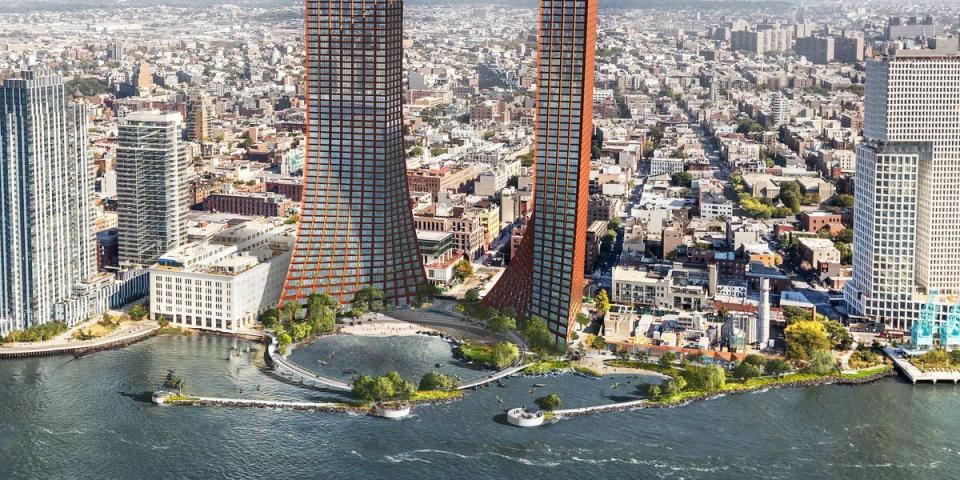Brooklyn Could Be Getting Two Massive Waterfront Apartment Towers

Whenever a city's skyline is set to change in a major way, you can bet the residents will panic just a bit. Anxiety is just one of the emotions New Yorkers might feel after checking out the plans for a new set of twin towers on the Williamsburg waterfront, unveiled today by Two Trees Management, James Corner Field Operations, and Bjarke Ingels Group (BIG).
The planned towers are massive, with one standing at 650 feet and the other at 600 feet. The buildings will include 1,000 units of housing, 250 of the units of which will be affordable housing and the other 750 at market rate. Along with a 47,000-square-foot YMCA and Olympic-sized swimming pool, there will also be office space and “community-oriented” retail space.
REVEALED: Massive Bjarke Ingels-designed apartment towers and public beach planned for Williamsburg https://t.co/W2zUkUJIsE@BjarkeIngels @BIGstertweets @fieldoperations @TwoTreesNY pic.twitter.com/pgAOqpssWU
— 6sqft (@6sqft) December 12, 2019
The River Street Waterfront Master Plan also proposes six acres of public space. "Our proposal closes one of the last remaining gaps in the continuous transformation of the Williamsburg waterfront into a post-industrial natural habitat," said Bjarke Ingels, BIG founding partner and creative director in a statement. “Rather than stopping at the hard edge of the old dock, Metropolitan Avenue is split into a pedestrian loop extending all the way in to the river, connecting the dots of the concrete caissons to form an urban archipelago of recreative islands while protecting a beach and body of water for water sports and wetlands.”
To protect the waterfront, while also providing public access to the water, the proposal plans to excavate some of the waterfront. This would allow it fill with water and help reduce flooding. According to Fast Company, the plan also includes building breakwaters, barriers meant to protect the coast from waves, that extend into the river. On top of the breakwaters, there will be paths to an outdoor tidal classroom, picnic groves, and spots for birdwatching.
A post shared by James Corner Field Operations (@fieldoperations) on Dec 12, 2019 at 11:56am PST
“We investigated the opportunity to stretch the Williamsburg waterfront landward with a circular pier and protected cove for water-based activities, inviting New Yorkers to take back and enjoy the river as a social and ecological public amenity,” said BIG partner Daniel Sundlin in the statement. “Surrounded by a necklace of recreation, educational and commercial programs, we envision the historic piers to be renewed and teeming with life.”
🏙💦@FastCompany ft. our River Street Waterfront Masterplan vision, in collab with @TwoTreesNY & @fieldoperations! Our proposal seeks to enhance waterfront connectivity, restore natural habitats & transform the way #NewYorkers interact with the East River: https://t.co/2EE5zA8K7j pic.twitter.com/dtlEAzTx58
— BIG (@BIGstertweets) December 12, 2019
To proceed with the proposal, the City Hall and the Department of City Planning will need to approve the project. Two Trees Management must also receive permits from the Department of Environmental Conservation and the U.S. Army Corps of Engineers. The review process could take two years to complete, and the construction could take at least five years—so the real panic (or excitement) can wait nearly a decade, okay?
Follow House Beautiful on Instagram.
You Might Also Like
